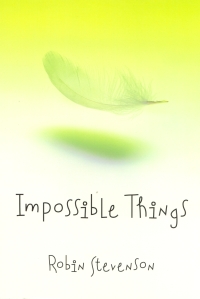| ________________
CM . . .
. Volume XV Number 5. . . .October 24, 2008
excerpt:
With her nonchalant demeanor and funky thrift-store accessories, Cassidy Silver seems to have a cool exterior, but she knows she's just an actor. In a family of geniuses, she feels ordinary…and lonely. Not only does she have to deal with school bullies and absent parents, she also has no friends. That is, until Victoria comes along – she seems to have telekinesis, and she promises to teach this ability to Cassidy. Cassidy thinks that telekinesis might help her escape her perceived ordinariness, but she doesn't know if she can believe that Victoria truly has a magical ability. Will Cassidy solve her problems through the use of magic or through learning more about other people … and about herself? Through the eyes of 12-year-old Cassidy, Impossible Things looks at various aspects of adolescence, including the pecking order in the classroom, family dynamics, and the burden of expressing individuality. In particular, this is a nuanced story about the complicated politics of bullying at school. Cassidy is tormented by classmates Amber and Madeline who have effectively driven all of her peers away from her, including her former friend, Chiaki. In particular, the two girls tease her about her former lisp and her second-hand clothing: "Oh, look. It's Cathidy. Nithe pants, Cathidy. Thalvation Army?" The novel explores what can happen when the positions of power change; that is, when those who are bullied suddenly become the bully. Cassidy, for instance, finds that she has to learn what to do when the tables suddenly turn as she becomes a leader in a group project and Amber loses her power to torment her. A key thought from the story is that it's easier to accept people for who they are when you make the effort to get to know them, as Cassidy comments: "It was a lot harder to hate people when you knew more about them." A lesson that we think we know, but is easily forgotten. I was uncertain about why Cassidy pressures Victoria to use her telekinetic ability for special ends, especially to stop a Grade 4 bully from abusing her brother, Ben. Of course, Cassidy wants the abuse to stop, but I wasn't entirely clear on her motivation since she is aware of how distressed Victoria feels about these requests. Cassidy is completely suspicious of her new friend, not only for the telekinesis, but for her story about her juvenile delinquent half-brother, Rick, who wants to use her power to rob people. I'm not sure why these doubts linger in her mind, especially since she is so happy to have finally made a friend in school. I was glad to see, however, that in the end, when she verbalizes these thoughts in front of the devious Rick - who is trying to abduct Victoria - she saves her friend with the power of her words. Fittingly, the novel traces Cassidy's journey to becoming a writer. She becomes aware of the power of language, both to hurt and to heal. With a teacher's praise of her talent, she decides to keep writing, especially to determine a few answers to the question 'Who is Cassidy Silver?' Clearly, as does any teenaged girl, she has much to write about. Impossible Things will appeal to adolescent girls, especially for those on the margins and who need more space, just like Cassidy. Recommended. A middle years teacher, Pam Klassen-Dueck is presently a graduate student in the M.Ed. program at Brock University.
To comment
on this title or this review, send mail to cm@umanitoba.ca.
Copyright © the Manitoba Library Association. Reproduction for personal
use is permitted only if this copyright notice is maintained. Any
other reproduction is prohibited without permission.
NEXT REVIEW |
TABLE OF CONTENTS FOR THIS ISSUE
- October 24, 2008.
AUTHORS |
TITLES |
MEDIA REVIEWS |
PROFILES |
BACK ISSUES |
SEARCH |
CMARCHIVE |
HOME |
